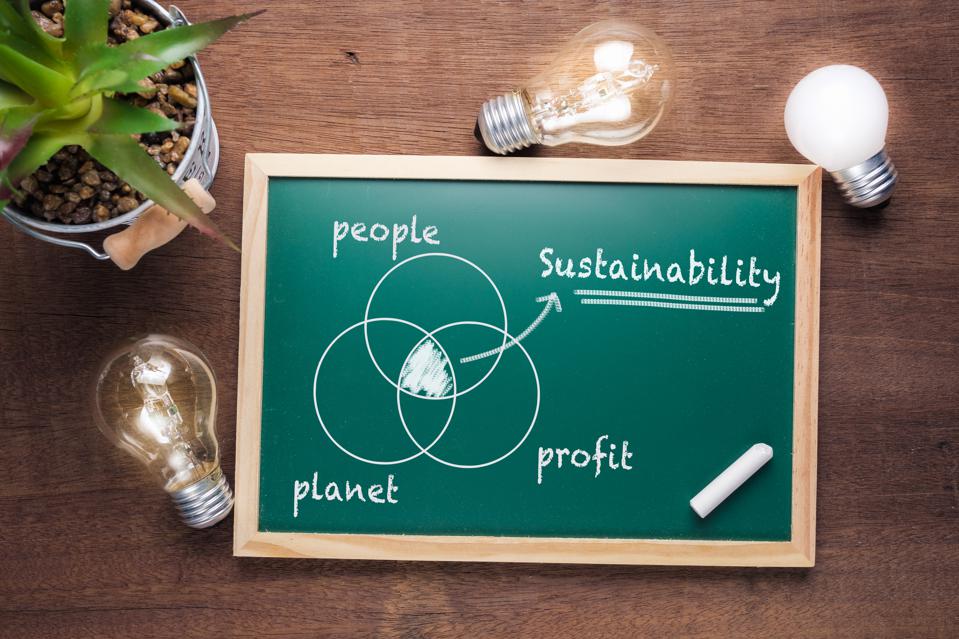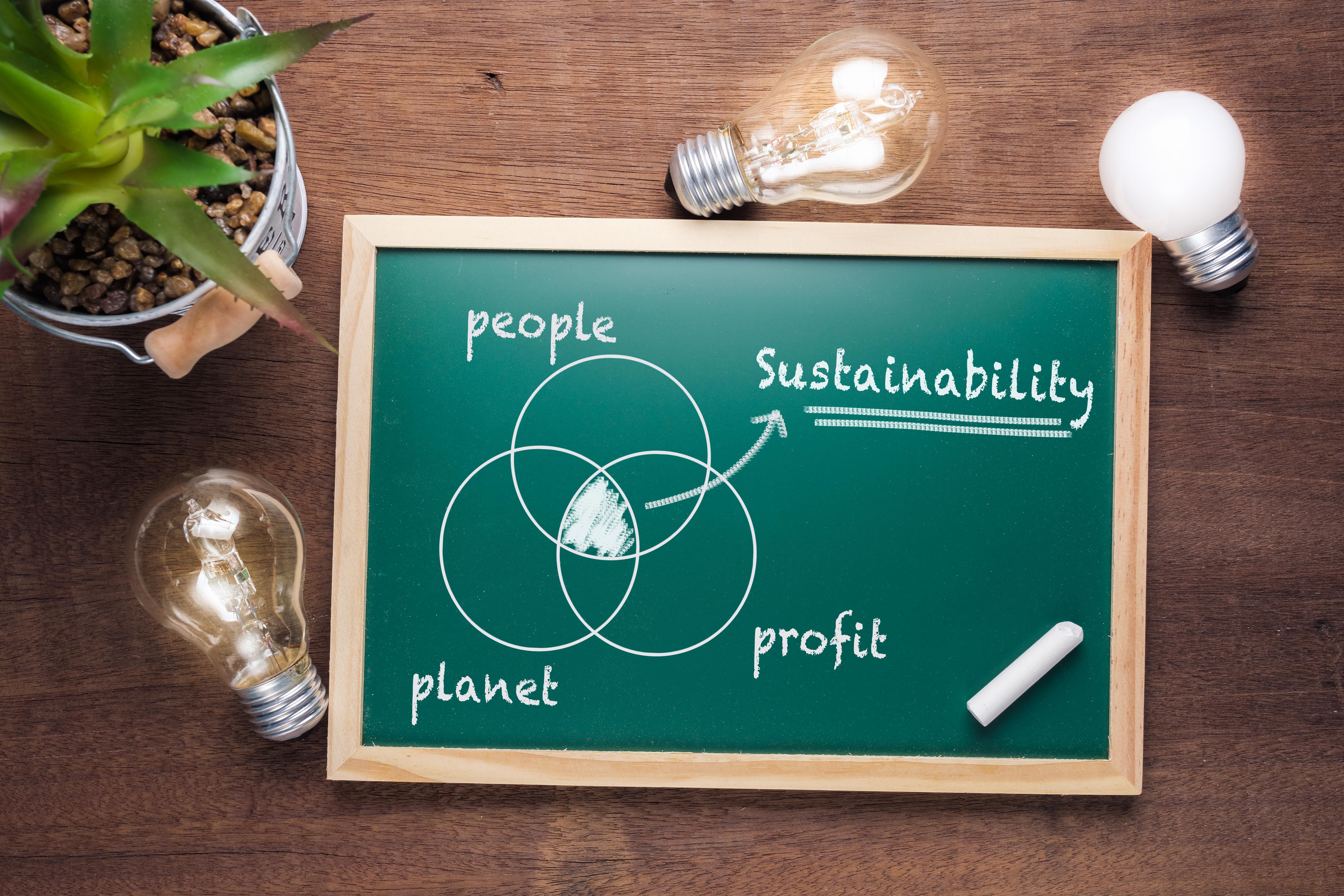Here are six things business leaders can do to stay on track to meet ambitious ESG goals—even during times of uncertainty.

Not all management teams and boards are up to speed on what their company can and should do to improve their footprint, even if employees have good data and solid proposals.
getty
In times of great upheaval, it can be difficult for businesses to see the big picture. Sure, making quick, data-driven decisions to reach the right customer at the right moment is important, especially when business is uncertain. But bigger aspirational goals are still essential—maybe more so.
This dynamic can be especially true when it concerns corporate sustainability—sometimes referred to as environmental, social, and governance (ESG) goals that measure the societal impact of a company or business. ESG goals are designed to allow businesses to meet their present needs without compromising the ability of future generations to meet their own needs. And ignoring those longer-term goals in the service of the here and now can undermine the future health of both the company and their customers.
In many ways, deprioritizing ESG goals in times of crisis is understandable. When economic strains are great and the business future looks cloudy, leaders often hunker down with a laser focus on the bottom line. But they must also continue to focus on the soul of their corporation, and what differentiates their products and their people.
Today, sustainability should be front and center for companies. Business leaders increasingly see sustainability as a key facet of their mission and build it into their principles and strategy to ensure business resilience. Further, they need to acknowledge the business risk of ignoring sustainability, whether through supply chain disruptions, public perception, or lack of investment in upcoming technologies.
A plan for progress
Table of Contents
First, let’s define our terms—what do we mean by “sustainability”? A good place to start is with the United Nations 17 Sustainable Development Goals (SDGs), a collection of 17 interlinked goals designed to be a “blueprint to achieve a better and more sustainable future for all.”
The SDGs include decreasing hunger and poverty, combating climate change, creating clean water, reducing income inequality, and forging better educational opportunities. They were set in 2015 by the U.N. General Assembly and are intended to be achieved by 2030.
Today, we hear quite a bit about climate change and the need to reduce carbon emissions, but sustainability is much broader—including environmental and societal impact. Not all management teams and boards are up to speed on what their company can and should do to improve their footprint, even if employees have good data and solid proposals. Here are six things business leaders can do to stay on track to meet ambitious ESG goals.
1. Make the business case
Sustainability makes business sense. A focus on ESG can help management reduce capital costs and improve the firm’s valuation. That’s because as more investors look to put money into companies with stronger ESG performance, larger pools of capital will be available to those companies. According to a study by the United Nations Global Compact and Accenture, “between 2013-2019, companies with consistently high environmental, social and governance (ESG) performance enjoyed 4.7x higher operating margins and lower volatility than low ESG performers over the same period.”
“Over the past several months, when global markets have faced tremendous pressures and volatility, companies with high ESG scores have continued to outperform, experiencing a cumulative relative return 6.3% higher than bottom performers and facing lower volatility.”
– Accenture report,
“The green behind the cloud,” September 2020
Additionally, according to a 2018 global survey by Accenture of nearly 30,000 consumers in 35 countries, 62% of respondents wanted companies to take a stand on current and broadly relevant issues, including sustainability. And 42% of consumers walk away from the brand in frustration if the company doesn’t align with customer beliefs.
2. Keep an eye on the data
Everything around us is affected by big data today and your work on sustainability should be no exception. Keep a close eye on measuring your goals, performance, and operational changes with data. Be especially mindful of the sourcing and reliability of the data collected. One big tire company, for instance, uses data generated by sensors in their tires globally to reduce waste, increase profits, and reduce the number of defective tires going to landfills, thus doing their bit for the environment. Small improvements in efficiency due to resource optimization can result in big savings.
Related: Unlock the transformational power of information you’re already collecting. Get the “CIO’s Guide to Data Analytics and Machine Learning.”
3. Make sustainability a key part of your executive structure
Organizations should have a chief sustainability officer and team working closely with line-of-business and tech leadership. The chief sustainability officer needs to be in board meetings and other gatherings where the long-term health of the company is considered. They must be a bridge between technologists and business strategists, pushing them to look at sustainability through a new lens—a technology lens—and asking how technology can help a company build a more sustainable world.
4. Expand your ecosystem
Reaching your sustainability goals doesn’t happen in a vacuum. It requires an ecosystem of both government and nongovernment organizations, researchers, scientists, technologists, and businesses, for example, who share the same views. Establishing this ecosystem enables collaboration through the sharing of knowledge, data, analytics, and technologies. Seek to collaborate with others who support and foster similar goals.
Throw out your regular playbook. Sustainability is not just about technology—it is about enabling change to the business processes. It requires us all to think much more collaboratively. We are in this together.
Google Cloud and Unilever, for instance, are working together to fight deforestation through sustainable commodity sourcing. By combining the power of cloud computing with satellite imagery and AI through Google Cloud and Google Earth Engine, Unilever is building a more holistic view of the forests, water cycles, and biodiversity that intersects their supply chain—raising sustainable sourcing standards for suppliers and bringing them closer to their goal of ending deforestation and regenerating natural resources.
This will allow Unilever to provide a better picture of the ecosystems connected to their supply chain, and create a better mechanism for detecting deforestation. Ultimately, it will lead to greater accountability while simultaneously prioritizing critical areas of forest and habitats in need of protection.
5. Be an internal evangelist for change
As a business leader committed to helping the organization meet ambitious ESG goals, being an internal evangelist and continuously championing the importance of sustainable practices is key. Make it your mission to reinforce the mindset that sustainability is not optional—it’s imperative not only for the success of the organization but for much broader, purpose-driven motives beyond that. Work on collaborating with other managers to propose and execute on initiatives to “green” operations within each department. Commit to following through on these initiatives, measuring the impact, and improving the effectiveness as you go.
6. Make bold commitments—even if the path there isn’t clear
As Accenture underscores in this September 2020 report on how a thoughtful cloud-first approach can help boost your profits and benefit the planet, “the greater the ambition, the greater the reduction in carbon emissions.” Broaden the scope of possibility by setting ambitious sustainability goals and timelines for your organization. You might not know how to get there, but making bold, transparent commitments opens the door for increased collaboration and sets the direction for others who might be able to help find a way.
For example, in September Google announced a new goal to operate on 24/7 carbon-free energy in all our data centers and campuses worldwide by 2030. Sundar Pichai, CEO of Google and Alphabet was candid, saying, “this is far more challenging than the traditional approach of matching energy usage with renewable energy, but we’re working to get this done by 2030.” Establishing executive buy-in, setting shared goals, enforcing accountability, and consistently measuring and evaluating your progress will make all the difference when it comes to moving the needle.
It may be hard to do, but I believe that now, even during a global crisis, sustainability should be at the center of a business’s decision-making. Sustainability is not only good for your bottom line, but it’s also good for your top line and good for the planet—the perfect trifecta.
Keep the momentum going: Reduce your environmental impact with Google Cloud. Explore tools and technology for sustainability at scale.







